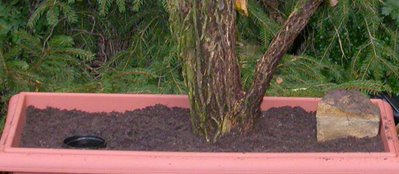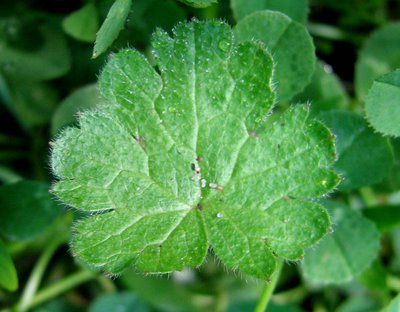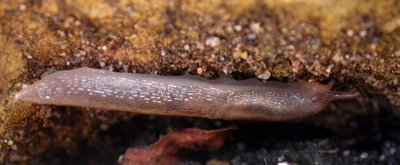For my second entry on this web log I have covered the history of the project to date.
On 4 November 2005 I bought a windowbox 63.5cm x 24cm, 0.1524 square metre (top inside dimensions) and two bags of John Innes No. 3 compost (the latter because it is 'ordinary' fertile soil, but sterilised ) at the Blackbrooks Garden Centre in Sedlescombe. These cost £11.97.
Helped by my grandson Jamie I set up the windowbox on some upturned wire crates so that the soil level was 65cm (26 inches) above the ground in a well-lit position to the west of the office shed in the garden. We filled it with the compost and put a dead elder branch in the centre, a pond made from a black plastic half litre mug to the left of this and a small rock of local sandstone to the right.
On 7 November 2005 I removed the elder branch (that did not last long) and replaced it with a 15cm mean diameter log of grey sallow, Salix cinerea, buried upside down in the soil so that about 17 cm of wood projected. This created a much more stable feature that will not fall over as it decays and is colonised by flora and fauna. The log was sawn from sallows being removed during the restoration of Oaklands Pond on the Pestalozzi Estate across the valley. The bark was left intact, but I hatcheted deep lines across the top of the log with a heavy bush knife to allow faster water penetration and therefore decay.
The first record from the windowbox was of a female non-biting midge, a brown and yellow Gymnometriocnemus brumalis found dead, floating on the surface of the pond. As this is a terrestrial breeding species, it would not have been attempting to lay eggs in the water.
It is very curious that this should be the first arrival as I have been interested in this species since 1959 and came across it on my parents' farm at Robertsbridge. I have seen it many times since and written odd bits and pieces about it for publication. If I had an insect talisman, or familiar, this would be it.
Birds come and sit on the sallow log and, although I have not yet seen one, there is ample evidence of their presence from the droppings they leave behind. Always too there is a scatter of leaves, mostly alder buckthorn as there is an old tree nearby, but also oak and hawthorn. Some have blown into the pond thereby started to enrich the water so that there will be some nourishment for the first colonists.
On 22 November 2005 there was a blackbird hopping about on the earth and the windowbox rim. Interestingly it pecked repeatedly at the earth as though there was something to eat there but, so far as I can see, it is absolutely bare apart from a few autumn leaves (currently being left where they lie).
The soil has been hard frozen during recent frosty nights and the pond covered with ice. The similarly sized pond in another project down the garden does not freeze like this unless the weather is much colder because it is buried in the ground and is in a sunnier position. This indicates that the microclimate in the windowbox is relatively harsh.
On 23 November the small psocied. Ectopsocus briggsi, was found on one of the fallen alder buckthorn leaves lying on the surface of Wbx's soil. An even smaller chalcid wasp was settled on the terracotta-coloured plastic rim of Wbx the following day - one of the difficult things to identify. The next day a robin perched on the sallow log in the morning, chirping and shaking its wings, pehaps because it was irritated by another robin somewhere. On 26 November there was one woodlouse under the sandrock. It proved to be the rather scarce Porcellionides cingendus, once a mainly western British species that has been spreading eastwards rapidly in recent years.
The foll,owing day I put a seedling wild service tree, Sorbus torminalis, into a small bonsai pot and buried this up to its rim in the front left hand corner of Wbx. This breaks my rule of no deliberate introductions, but I will not put it down as a record and, through being in a pot, it remains only semi-attached to the project and will not reproduce itself. My plan is to train it so that it casts a little shade over the sandrock and my other excuse is that I just like it there.
Yesterday's Porcellionides cingendus woodlouse was joined the next day by a couple of raw salmon coloured pigmy woodlice Trichoniscus pusillus. It is quite a climb for these small creatures and they must make their way up the wire cages that support Wbx like steel workers on skyscrapers. The Mohawks of the invertebrate world.
On 2 December a vine hopper, Empoasca vitis, settled like a small green seed on the south edge of the box. These are very common about the garden in winter, sheltering in evergreens and similar, but always active in milder weather. The following day another small chalcid wasp floated on the pond. I lifted it out on my fingertip and, after a few moments,it shook its wings and flew off. There was an owl fly too, a Psychoda species, standing on the meniscus of the pond. I left it there and when I returned, it had gone. Clearly they are able to walk on water.
On 16 January 2006 a tiny plant of moss was detected close to the eastern rim in the northern half of the windowbox. I suspect it had fallen off a bird, rather than grown from a spore. Nevertheless, it looks as though it may persist. Over the last few weeks the soil surface has been distrubed from time to time, probably by birds, leaving small hills and hollows which I have left as they are.
On 18 January 2006 the first seedling appeared, a tiny dicot in the northern section of the box near the eastern rim, but closer to the central log than the moss discovered two days ago. Then, on 1 February 2006, a second, even smaller, seedling appeared just in front of the sandstone rock. Eight days later I found and orange-scarlet berry lying on the earth near the pond. It was a fruit of stinking iris, Iris foetidissima, presumably dropped by a visiting bird. I do not expect it will remain there long and it raises the question of whether to record it for the species list. I think the answer is 'yes', on the basis that it is, unlike a fallen leaf, a complete, living organism with the capability of growing to maturity and reproducing itself.
On 10 February 2006 nearly half the water had disappeared from the pond when I looked at Wbx in the morning, so I topped it up with rainwatwer. There had been a hard frost overnight and some thirsty bird or birds might have found this as one of the few available drinking points if others were iced over, though the pond normally freezes when there are subzero temperatures.
I also spotted a small, bright green disc near the sallow log. This turned out to be a single plant of duckweed, probably lesser duckweed, Lemna minor, transported no doubt from the nearby pond by a bird. I broke, or bent, one of my own rules by moving the plant a few centimetres into the pond as it would have died on the bare earth. Let's call it conservation management. Again, as with the stinking iris seed, it was a good record as it was a whole organism capable of reproducing itself.
The iris berry had disappeared by 19 February and the duckweed plant was twice splashed out of the pond by heavy rain. The first time I returned it to the water, but I could not find it on the second occasion so the colonisation attempt has been unsuccessful. However, a third seedling has appeared to the north west of the sallow log. A small crescent of green too timid to unfold above the surface of the soil. The weather has turned cold again, so this is slowing growth, but the other two seedlings look in good shape and may be establishing root systems rather than developing overground.
The cold carried on until I set up this web log on 3 March 2006 and little happened in the interim, except for a day when quite a bit of the soil surface was disturbed by a visiting bird which almost destroyed the two surviving seedlings.
















































